Inside the voice campaigns: how muddled messages and voter confusion led to a crushing defeat
On Saturday evening, in a nondescript office in North Sydney, Yes23 campaigners and their supporters – 80 or so people – gathered to watch Australians reject the Indigenous voice to parliament.
It had been a dry campaign, but people permitted themselves a tipple and something to eat. Nobody at the private wake was surprised as the results came in. Before the result had even been confirmed, Marcia Langton had declared reconciliation was “dead”.
People watched intently as Tanya Hosch, a board member of Yes23, articulated her “huge disappointment” on the ABC’s live broadcast and reasoned that the task now was to mobilise the millions of Australians who had voted yes.
“We are going to have to bring that together and maintain that, because that is going to be the strength of what enables us to move forward in a way that is constructive, and actually means that Aboriginal and Torres Strait Islander people do start to live like equals in their own country,” she said.
Televisions in North Sydney were switched to the ABC broadcast and to the live call of the results on Sky News, but someone pulled the plug on Sky when the network cut to a break just as Dean Parkin started speaking from the public function in Ashfield.
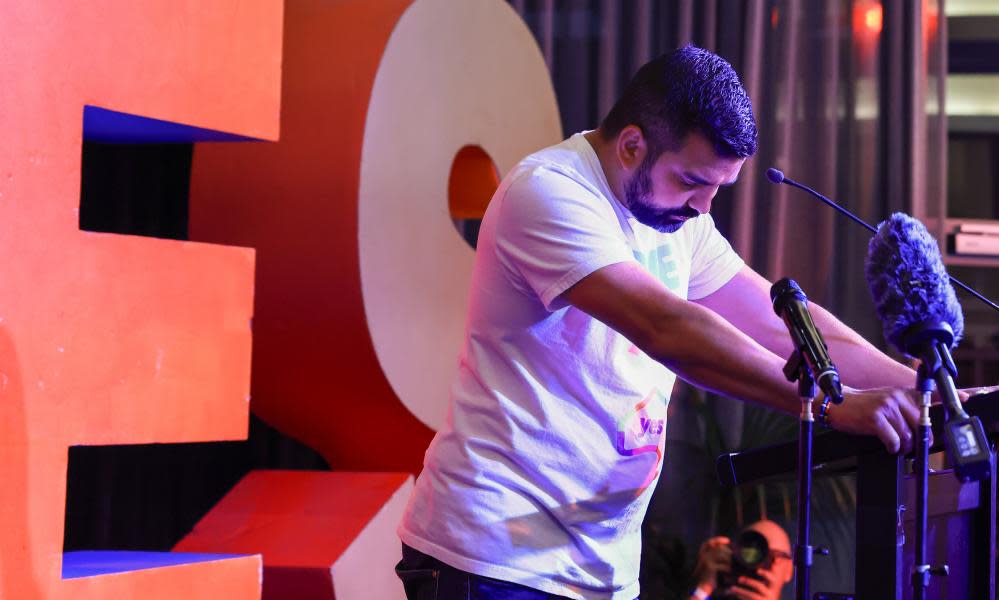
People watched Anthony Albanese acknowledge the defeat from parliament house. There were speeches. Danny Gilbert a lawyer, company director and philanthropist and one of the co-chairs of the board, thanked people for their effort and commitment.
Knowing you are going to lose a campaign never quite prepares you for experiencing it, and this wasn’t just a campaign. This was a request from the original inhabitants of the continent to restructure conversations between Indigenous people and government – a request grounded in the history of dispossession and silencing.
The rebuff felt savage. This was a big opportunity to lose. Tears flowed. The mourning was visceral and deep. But later in the night, when some of the group kicked on after the North Sydney wake, resilience had returned to the fore. The mourning was laced with defiance.
The voice was dead. Time to regroup. Time to consider what next.
Muddled messaging
Organisations that would spearhead the “no” campaign were marshalling from August 2022. Janet Albrechtson, a columnist for The Australian, has put together a fascinating account of how the naysayers came together. Ginger groups. Lawyers. Thinktank types. John Roskam, a former executive director at the Institute of Public Affairs. According to Albrechtson’s timeline, Advance Australia – one of the main groups leading the charge – resolved by September last year to run the no campaign. The advocacy group began “recruiting support” from members in December and was undertaking field research by early January.
The no camp shifted in shape and tack over the campaign, but always went out of its way to claim underdog status. Warren Mundine’s group, Recognise A Better Way, was the first to lay claim to “official” no campaign status, pulling together a motley crew, including controversial former Labor minister Gary Johns, former Nationals deputy PM John Anderson, and Country Liberal senator Jacinta Nampijinpa Price, a Warlpiri woman and former deputy mayor of Alice Springs.
Nampijinpa Price would later split off, linking up with Advance – the group for which she’d formerly been a spokesperson – to front a no campaign they called Fair Australia.
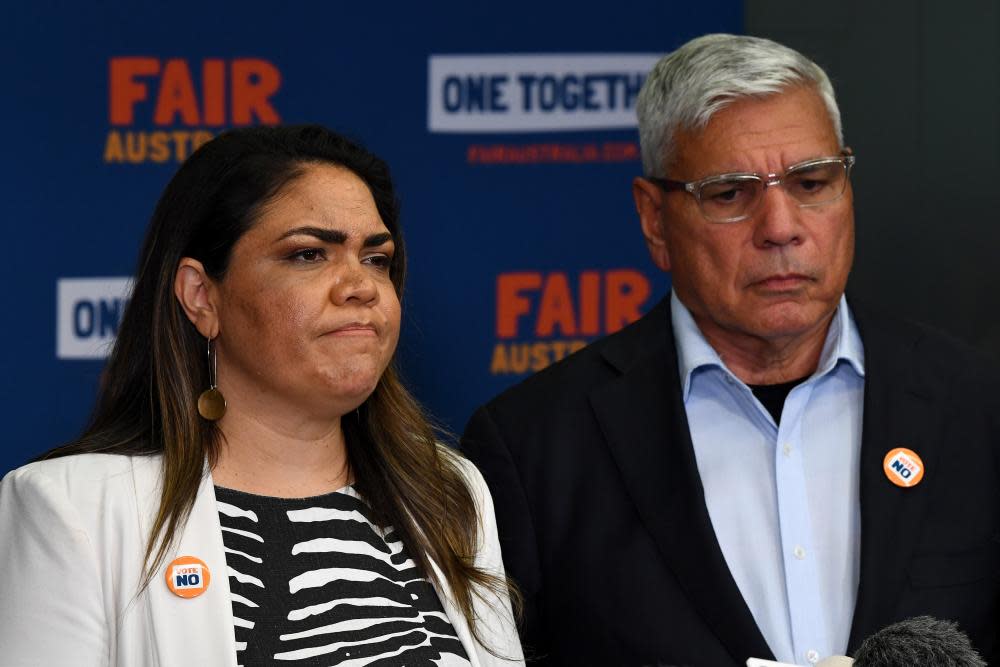
Fair and Recognise worked alongside each other for a period – in tandem, if not in total harmony – before Mundine rolled his campaign into Advance’s and became co-leader publicly alongside Nampijinpa Price. Various confected outrages, including criticism they hadn’t been granted tax-deductible gift status, came from this chopping and changing – Mundine had complained about, but had not applied for, DGR status for Recognise A Better Way. That status was granted and listed in the May 2023 budget papers, but Mundine withdrew the application as the two campaigns merged. The merged entity, Australians for Unity, would be quickly granted DGR status once the paperwork was actually lodged and the no campaign resolved its forward direction.
That’s where it was lost. We were too slow
Yes campaigner
Advance is not officially attached to the Liberal party, despite numerous crossovers in staff and goals. Initially coming to prominence for its spectacular failure to keep Tony Abbott in Warringah against the challenge of Zali Steggall in 2019, and a series of bizarre stunts and controversial billboards in 2022, some Liberal sources questioned “why we’re playing around with them”. Despite the federal Coalition’s official stance to oppose the voice, many Liberal staffers declined to hand out flyers or stand at pre-poll booths for the no side.
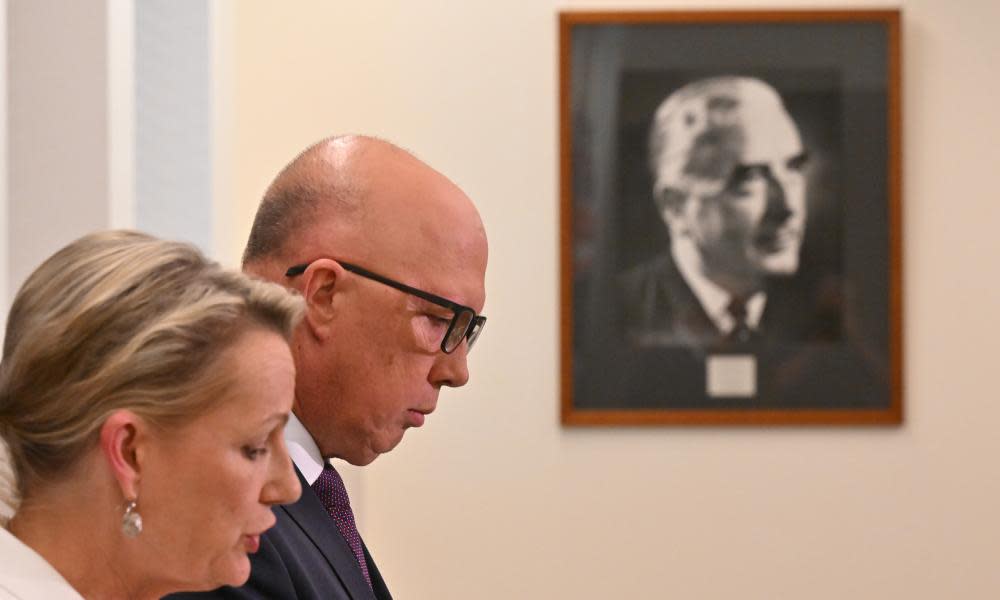
There are some in the yes campaign who believe the referendum was lost at the point where Peter Dutton returned to work in January 2023 with a list of 15 questions about the voice to parliament. The previous November, the Nationals had decided to oppose the proposal. Nampijinpa Price expressed her opposition to the voice standing alongside the Nationals leader, David Littleproud.
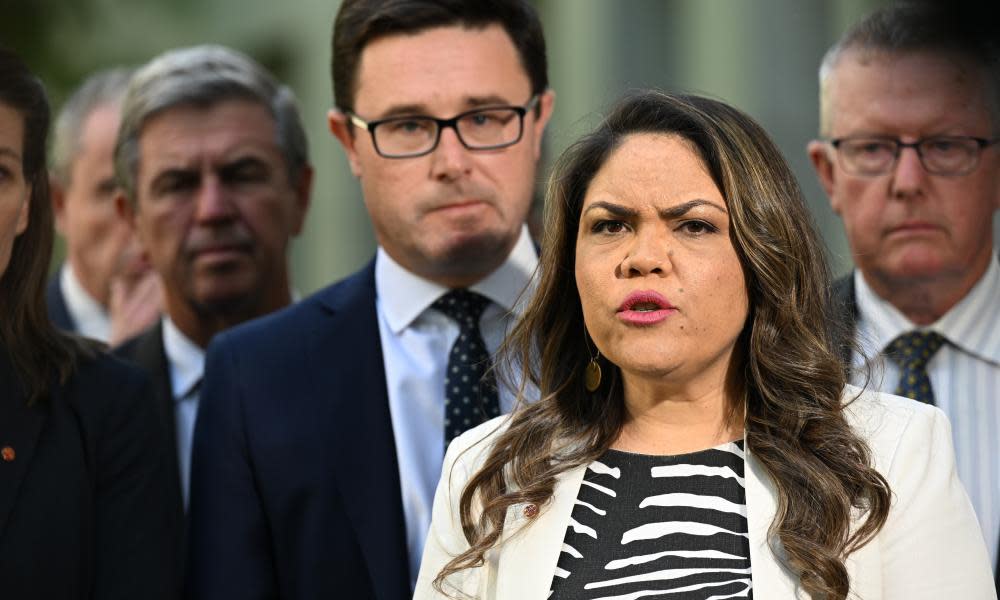
Nampijinpa Price rehearsed one of the key tropes the no side would promulgate successfully during the campaign, contending the voice would “divide us along lines of race”. In his letter to Albanese that was sent to the media at the same time, Dutton landed a second significant trope of the no campaign – where is the detail? In time the messaging would ramp up to so-called “elites” versus the outer-suburbs.
At this point, Dutton had not locked the Liberals into a no position. But the tone of his letter was pugnacious. It felt like a portent of conflict. But some in the opposition insist Dutton was attempting to keep his options open, despite being lobbied by fellow right wingers in his party to line up, pronto, with the Nationals.
Some Liberals say the 15 questions foray was a public signal that Dutton wanted to negotiate. One says the hope was the volley of questions would prompt Albanese to bring Dutton to the table; to put everyone in a room, articulate some parameters and test whether there was any prospect of agreement.
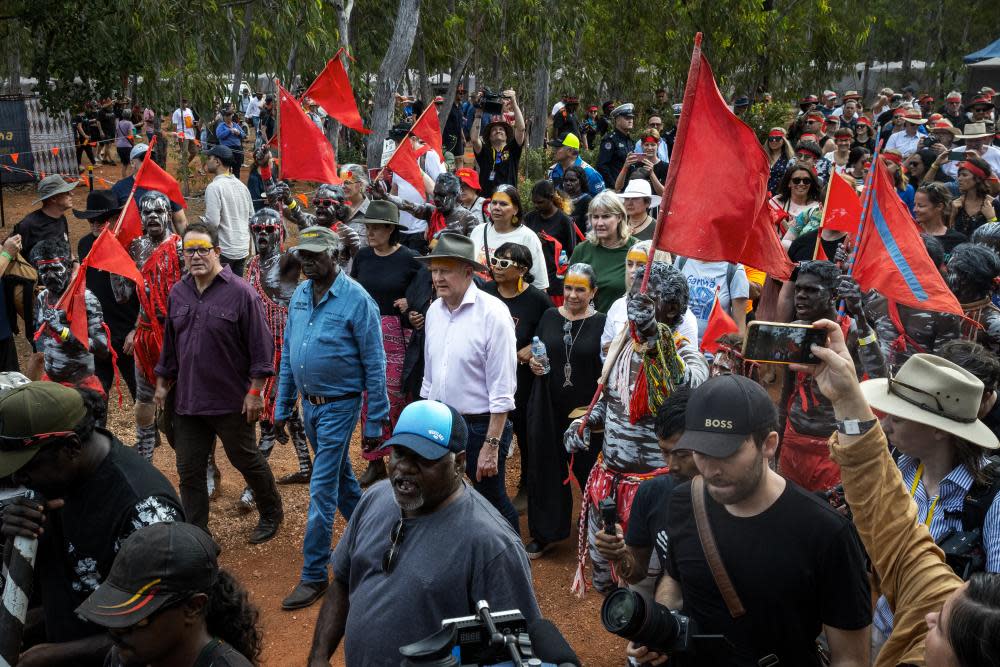
Albanese had taken the opposition by surprise by announcing the wording of the referendum question on the constitutional amendment at the Garma festival the previous July. While Albanese made it clear at the time he regarded the three sentences as a “starting point” for dialogue, Liberal voice supporters felt Albanese – buoyed up by his post election honeymoon and at the zenith of his internal authority – effectively locked them out from that point by telegraphing words publicly in advance of any process to test and build political consensus. Some Liberals also wanted a two-step strategy, legislating a model then moving to a referendum.
While Albanese had hoped initially that Dutton might be able to be persuaded to support the voice – the appointment of Julian Leeser as the shadow minister for Indigenous Australians, a longtime supporter, was considered a hopeful sign – the prime minister thought the chances of that were remote, given the hostility from Dutton’s conservative base. When it came to prosecuting the voice, Albanese had hoped to be dealing with Josh Frydenberg post-election, not the Queensland right-winger.
Getting Dutton on board would have involved the government finding a model that could be supported by both Nampijinpa Price and the Indigenous leaders who had crafted the Uluru statement, particularly Megan Davis.
In the real world, this seemed a stretch, to put it mildly. Davis was very clear she wanted the voice to make representations to parliament and the executive government. Some moderate Liberals who might have been persuaded to campaign for yes were strongly opposed to that wide remit. One in that camp says: “The government strapping themselves to the referendum working group was a mistake. No one was prepared to call Megan’s bluff.”
Related: Guardian Essential Report: how the polls were right about the voice - podcast
This analysis is logical, but the counter-factual was also obvious: how could the government go to the voters proposing a voice that the original architects of the voice were fully prepared to disavow? That position is untenable for a prime minister who had promised to listen to Indigenous people.
This strange tango – Dutton demanding detail, Albanese pointing to the wealth of detail in previous parliamentary and other reports about the voice, Liberal moderates hoping there was a universe where very obviously irreconcilable differences of policy and strategy could somehow be resolved – continued until just after the Liberals lost the Aston byelection in April.
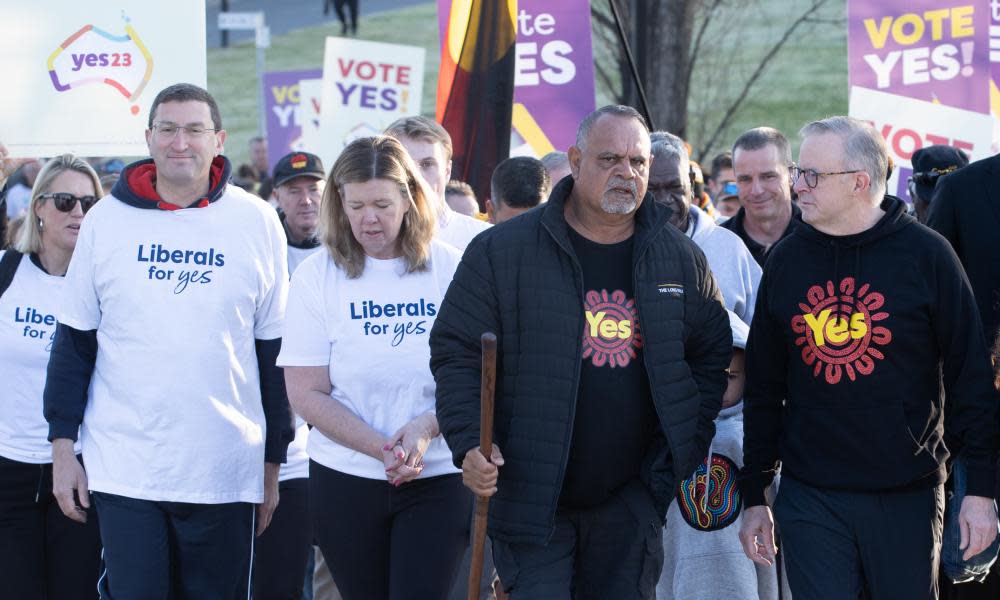
After that electoral blow, Dutton said no to the voice, Leeser left the opposition frontbench and Nampijinpa Price was installed in Leeser’s former shadow ministry.
Australia entered a brutal cycle of structural division. And public support for the voice started to tumble.
Sowing voter confusion
The yes campaign was an unusual beast. There were two bodies – the Yes23 campaign and the Uluru Dialogues entity headed by Megan Davis and Pat Anderson. A dual structure is an unconventional campaign setup; it’s not a model for efficiency.
It was clear in real time, and it’s crystal clear in hindsight, that the yes campaign began flat footed. It lost the critical opening messaging war. Dutton’s questions about the voice over the summer became definitional in the minds of many voters. One insider says: “That’s where it was lost. We were too slow”.
Related: ‘Maybe I don’t have as many friends as I thought’: being Indigenous amid 85% no voters
The yes campaign spent months trying to reframe the conversation, but reaching people was laborious and commanding voter attention was difficult. The growing conflict in the referendum conversation was a turnoff for a lot of voters. The divisive algorithms of social media were working their dark magic, saturating voters in ad hominem and negativity.
Questions about the campaign’s planning and preparedness would be a common theme until polling day. In South Australia, one of few states allowing corflutes to be affixed to telephone poles, local campaigners said they’d been pleading for more of the plastic signs to arrive in the last few weeks. One campaigner said a huge load finally arrived on the Friday afternoon before the Saturday polling day.
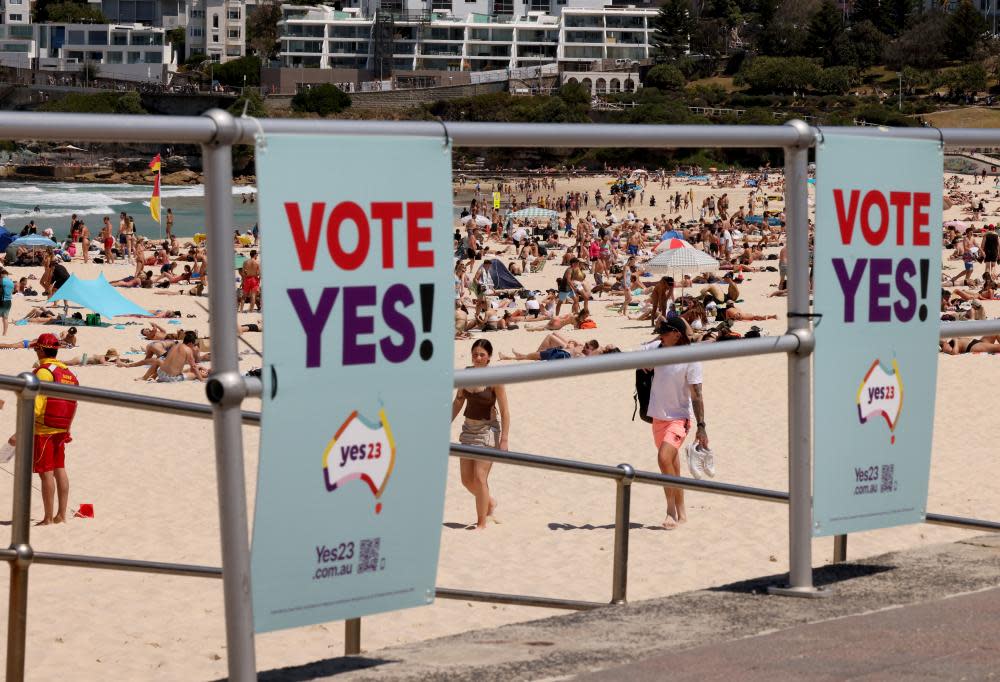
As the level of contention got dialled up, support from allies became more muted. Many in the yes campaign were puzzled and hurt that some sporting groups, many of which had made prominent public statements in favour of the voice and some of which had backed the Uluru statement for years, were not more forthcoming in their actual support during the campaign.
Some campaigners started comparing the level of tangible public support to that given to the marriage equality campaign. Major businesses and public organisations – some of whom had developed their own reconciliation action plans and Indigenous programs with help from the same Aboriginal leadership – had gone “missing when it mattered”.
Public polling, including Guardian Essential, tells us a number of Australians voted no because they thought the voice was divisive and the detail was not well understood. Nampijinpa Price rising to the opposition frontbench, becoming the no campaign’s effective figurehead, was also a visual demonstration that not all Indigenous people supported the reform. This reinforced another key no campaign message. The actual vote on referendum day painted quite a different picture, with very high yes vote in communities with large Indigenous populations. But by then, it was too late.
Public support for the voice held up through the first blow to bipartisanship – the Nationals declaring their hand. But Dutton’s decision to say no was a body blow. Private research undertaken for Yes23 and Labor’s private polling tracked a calamitous collapse in support for the voice among rusted-on Coalition voters shortly after Dutton declared his opposition. Most of that decline happened within a couple of months, particularly in more conservative parts of the country and support continued to bleed right up until the final few weeks.
Related: ‘Crushing Indigenous hopes’: how the media reacted to voice referendum loss
By August, no was ahead of yes in the Guardian Essential poll. Also in August, the director of Advance fronted the Conservative Political Action Conference in Sydney. He was direct about the strategy. Matthew Sheahan said the “no” campaign aimed to take advantage of voter confusion about the voice.
The process Sheahan described was like kicking an open door. The no campaign was able to “shape the conversation” because “very few people” knew what the voice was. Sheahan said the anti-voice group settled on its central argument – that the referendum would cause division – because that theme had been popular in focus groups. He said Advance’s strategy was to win three states to deny the yes campaign its required double majority of a national majority plus four of six states.
It wasn’t just Coalition voters who sunk the voice. There was a drop off in support from Labor voters too, but the trajectory was nowhere near as steep. In the end, every Australian state voted no.
Reluctant no voters
Not all no voters were a hard no. Campaign research suggests around half the no cohort were reluctant about it.
Liberal MP Bridget Archer campaigned for yes, but a majority of people in her marginal electorate of Bass voted no. Archer noted this reluctant no phenomenon talking to her constituents in northern Tasmania.
Archer describes this group as “middle Australia” no. “For the most part, they recognise the disadvantage faced by Indigenous people, they just disagree on the solution,” Archer says. “They feel a little bit uncomfortable about voting no, because they want to do something, they just didn’t want to do the voice for whatever reason.” She says this group were not going to “stand on a booth wearing a T-shirt that says ‘say no to division’ because they didn’t feel that way about it necessarily, they just felt unsure that the voice was the solution.”
Archer also encountered reluctant progressive no voters as she did the rounds.
With public support for the voice seemingly in freefall, the yes campaign changed tack radically as pre-poll voting opened. The campaign had tried to keep the core yes messaging about Indigenous aspiration rather than about problems. But the advertising strategy sharpened in the closing weeks. Television advertisements shot in black and white highlighted gaps in infant mortality rates, life expectancy and employment outcomes, with the tagline “A no vote means no progress”.
Related: Peter Dutton fails to find support for audit of government’s Indigenous spending
The campaign had reached the uncomfortable realisation, backed by research – that many no voters weren’t driven by racism, but more an “apathy”. Noel Pearson said in the closing week of the campaign the “overwhelming attitude” he’d picked up wasn’t racism but “a complete lack of empathy.”
Going negative is a common feature of political campaigns. But the Yes23 campaign did not want to confront Australians with negative imagery. One operative says the shift in strategy necessitated a huge number of conversations over the weekend before the advertisements appeared, both inside and outside the campaign. The Indigenous strategists asked themselves and each other: do we want to go there? What are the implications of going there?
People wrestled deeply with the switch. Campaign leaders spoke with a number of members of their broader engagement group. They needed sounding boards. By the end of the rolling conversations, there was near unanimous support for shifting strategy.
Support for yes was tracking in the low 30s nationally at that point. But the black-and-white campaign pulled the negative trend back. The improvement registered in some of the public polls, including Resolve and Guardian Essential.
But it was not enough. It was too late.
Fighting another day
While not all no voters were hard noes, a yes vote in the toxic and bitterly contested climate of the referendum was a hard yes. Yes voters proved to be a highly motivated cohort. With support from progressive political parties and civil society, Yes23 was able to assemble a significant ground game.
While the voice to parliament was defeated, the campaign – however flat footed at times – succeeded in building a new social movement. The question now, as Hosch said on referendum night, is how to hold and direct that yes cohort for the next chapter in the reconciliation story.
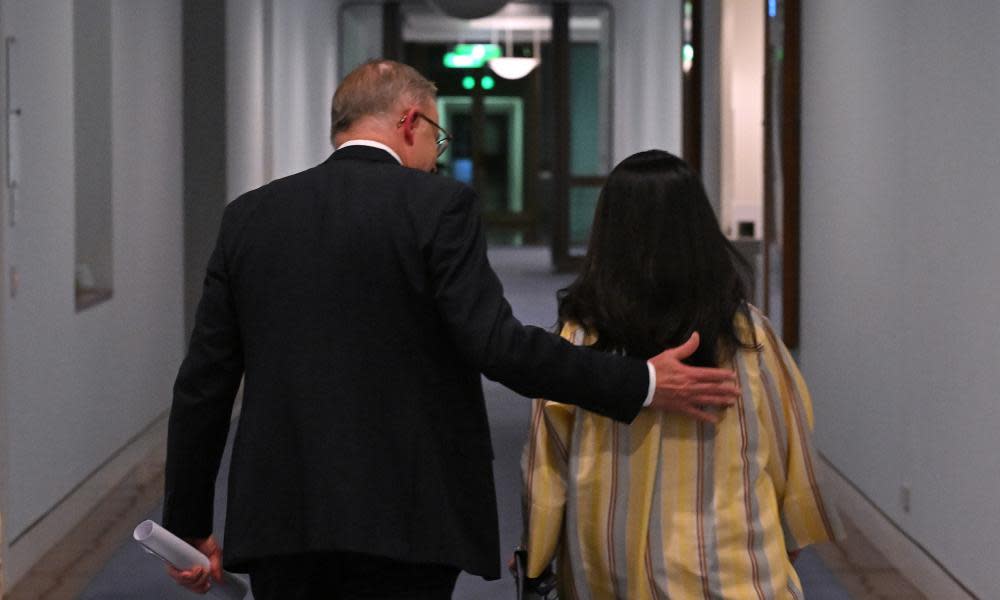
It also seems probable that the next chapter will be written by a new generation of Indigenous leaders who have gained cultural authority over the decade or more they have spent championing the cause of constitutional recognition. While older Australians clearly struggled to accept the need to radically reframe conversations in this country about the past and the future, polling suggests younger Australians will be allies in this cause.
For now, Australia’s reconciliation agenda is in flux. Indigenous leaders are caucusing among themselves after Saturday night’s defeat, but they have exited the national conversation for a week of mourning and reflection. In Canberra, a Labor prime minister who kept his promise about pursuing the voice is waiting for guidance once key people re-enter the fray.
The referendum campaign unleashed and emboldened forces of division and polarisation in our polity. Once unleashed, these forces can be hard to subdue. While yes built a social movement, the no campaign has also succeeded in uniting previously disparate forces in a coherent structure for the permanent campaign. If a constitutionally enshrined advisory body for Indigenous Australians can be weaponised successfully in a national culture war, so can many other things.
At the same time as the yes campaign was holding its wake in North Sydney, the no campaign was dwelling on its triumph at the Hyatt Regency in Brisbane. When many journalists left the gathering to observe a post-result press conference from Dutton on Saturday night, the richest person on the Australian Financial Review’s Rich List this year, Gina Rinehart, drifted through the lobby of the Hyatt Regency and made her way to a private no campaign event upstairs.
The nature of Rinehart’s association with this cause is unclear. But the discrete ascension of the reclusive mining magnate seemed an appropriately sardonic coda to a destructive campaign which had sought to cleave a country into tribes – the so-called “elites” and the rest.


